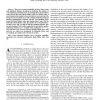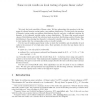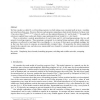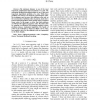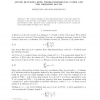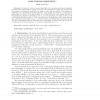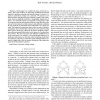TIT
2010
14 years 2 months ago
2010
The error correction capability of binary linear codes with minimum distance decoding, in particular the number of correctable/uncorrectable errors, is investigated for general lin...
PROPERTYTESTING
2010
14 years 5 months ago
2010
We study the local testability of linear codes. We first reformulate this question in the language of tolerant linearity testing under a non-uniform distribution. We then study th...
TIT
2002
14 years 7 months ago
2002
Abstract--Informally, an error-correcting code has "nice" listdecodability properties if every Hamming ball of "large" radius has a "small" number of ...
DAM
1998
14 years 7 months ago
1998
We first consider so-called (1,+s)-branching programs in which along every consistent path at most s variables are tested more than once. We prove that any such program computing...
TIT
2008
14 years 7 months ago
2008
The minimum distance is one of the most important combinatorial characterizations of a code. The maximum likelihood decoding problem is one of the most important algorithmic proble...
TIT
2008
14 years 7 months ago
2008
For a linear code , the stopping redundancy of is defined as the minimum number of check nodes in a Tanner graph T for such that the size of the smallest stopping set in T is equal...
DM
2007
14 years 7 months ago
2007
We construct families of three-dimensional linear codes that attain the Griesmer bound and give a probablistic construction of linear codes that are close to the Griesmer bound. Al...
CORR
2007
Springer
14 years 7 months ago
2007
Springer
We relate the notion of matroid pathwidth to the minimum trellis state-complexity (which we term trellis-width) of a linear code, and to the pathwidth of a graph. By reducing from ...
CORR
2006
Springer
14 years 7 months ago
2006
Springer
This paper discusses a stylized communications problem where one wishes to transmit a real-valued signal x Rn (a block of n pieces of information) to a remote receiver. We ask wh...
INFOCOM
2002
IEEE
15 years 9 days ago
2002
IEEE
Abstract— In this paper we consider the issue of network capacity. The recent work by Li and Yeung examined the network capacity of multicast networks and related capacity to cut...
